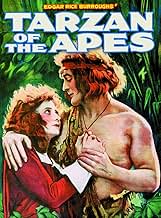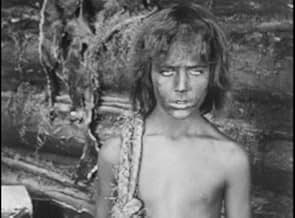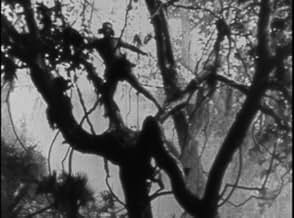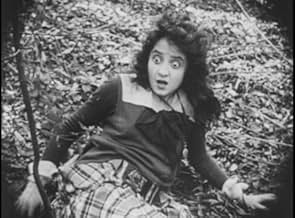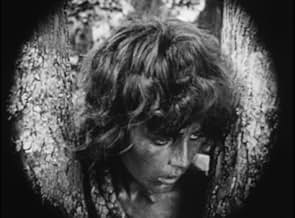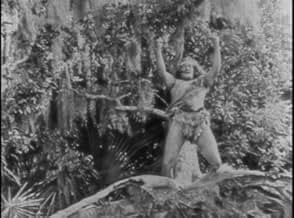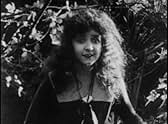IMDb-BEWERTUNG
5,7/10
985
IHRE BEWERTUNG
Als John Clayton und Frau im Dschungel sterben, wird deren kleiner Sohn von der Äffin Kala aufgezogen. Jahre später will Prof. Porter prüfen, ob jener Tarzan der Clayton-Erbe ist, während Ta... Alles lesenAls John Clayton und Frau im Dschungel sterben, wird deren kleiner Sohn von der Äffin Kala aufgezogen. Jahre später will Prof. Porter prüfen, ob jener Tarzan der Clayton-Erbe ist, während Tarzan sich in Porters Tochter Jane verliebt.Als John Clayton und Frau im Dschungel sterben, wird deren kleiner Sohn von der Äffin Kala aufgezogen. Jahre später will Prof. Porter prüfen, ob jener Tarzan der Clayton-Erbe ist, während Tarzan sich in Porters Tochter Jane verliebt.
- Regie
- Drehbuch
- Hauptbesetzung
Madame Sul-Te-Wan
- Esmeralda - Jane's Maid
- (Nicht genannt)
Stellan Windrow
- Tree-Swinging Tarzan
- (Nicht genannt)
Empfohlene Bewertungen
If someone watches this film and starts looking for shortcomings, they'll probably find a reasonable amount. However, considering the film was made in 1918, it's an amazingly good film--even with its few mistakes and cheesy touches--which, relative to other films of the day, were few.
This original Tarzan film was made in Louisiana. I live in Florida and I could tell by looking at the plants that it was filmed in this part of the USA, but considering that many later Tarzan films were filmed with houseplants all over the set, the backwoods of Louisiana (with all its Spanish moss) was a good choice for a domestic production. As far as the wild animals go, it was a mixed bag. Unfortunately, the elephant was an Asian elephant but I can't blame the film makers too much--the African variety are a lot nastier and dangerous. What I can blame them for, a bit, are the apes that adopt Tarzan. They are clearly people in cheap ape costumes--that look neither like gorillas or chimps--just people in ape costumes! But once again, given the technology of the era, it isn't that bad--plus, Stanley Kubrick did the same thing in "2001" and it's considered a masterpiece!! As for the plot, aside from the addition of a character and a few other small changes, it is essentially Edgar Rice Burroughs' book come to life. It's actually much more accurate than many of the later versions and because it stays closer to the book, it is more interesting and watchable...and less silly. In fact, as far as the writing, direction and acting go, it was all very, very good for such an early full-length film--and a lot better than the gobs of Tarzan films from the 1950s and 60s.
Overall, very good and very interesting.
This original Tarzan film was made in Louisiana. I live in Florida and I could tell by looking at the plants that it was filmed in this part of the USA, but considering that many later Tarzan films were filmed with houseplants all over the set, the backwoods of Louisiana (with all its Spanish moss) was a good choice for a domestic production. As far as the wild animals go, it was a mixed bag. Unfortunately, the elephant was an Asian elephant but I can't blame the film makers too much--the African variety are a lot nastier and dangerous. What I can blame them for, a bit, are the apes that adopt Tarzan. They are clearly people in cheap ape costumes--that look neither like gorillas or chimps--just people in ape costumes! But once again, given the technology of the era, it isn't that bad--plus, Stanley Kubrick did the same thing in "2001" and it's considered a masterpiece!! As for the plot, aside from the addition of a character and a few other small changes, it is essentially Edgar Rice Burroughs' book come to life. It's actually much more accurate than many of the later versions and because it stays closer to the book, it is more interesting and watchable...and less silly. In fact, as far as the writing, direction and acting go, it was all very, very good for such an early full-length film--and a lot better than the gobs of Tarzan films from the 1950s and 60s.
Overall, very good and very interesting.
This is the first and oldest Tarzan movie ever made, as far as I know. Interesting mainly for that point. For the rest, I will always prefer Johnny Weissmuller as the Tarzan character, and I suppose I am not the only one to think like this. Elmo Lincoln could have been replaced by a more convincing actor, more athletic. OK, it tries to speak of the true, genuine story of Tarzan, according to the Edgard Rice Burrough's novel, as Hugh Hudson did in 1984. This is a good point that can justify to watch this rare item, xanks to TCM. This is also a shame that so many features fromt he silent era are now lost forever.
Cinema's first adaptation of Edgar Rice Burrough's famous novel sees screen strongman Elmo Lincoln claiming a place in cinematic history in the title role. With his bulging eyes and crazed grin, he's a strangely unhinged version of the ape man, but Lincoln's eccentric portrayal somehow makes him all the more convincing. Although only a 60 minute version of the original 2-hour film survives, the plot remains both coherent and remarkably faithful to Burrough's famous novel, and the swamplands of Louisiana provide a convincing substitute for the African jungle.
...because of his already established reputation as a Hollywood strong man (e.g. his role as the Mighty Man of Valor in the 1916 DW Griffith classic "Intolerance").
Also, the image of Tarzan in 1918 was not that of a lithe gymnast like Christopher Lambert in "Greystoke", but of a man powerful enough to wrestle lions. Strength equalled bulk.
There's an interesting piece of trivia attached to that movie and Uganda (that's in East Africa) where I'm now based. There's a popular myth around here that the 1918 version of "Tarzan of the Apes" was filmed on the northern shores of Lake Victoria. In fact it was shot, I believe, in Louisiana.
Also, the image of Tarzan in 1918 was not that of a lithe gymnast like Christopher Lambert in "Greystoke", but of a man powerful enough to wrestle lions. Strength equalled bulk.
There's an interesting piece of trivia attached to that movie and Uganda (that's in East Africa) where I'm now based. There's a popular myth around here that the 1918 version of "Tarzan of the Apes" was filmed on the northern shores of Lake Victoria. In fact it was shot, I believe, in Louisiana.
At this early point in American film history, Tarzan of the Apes was an instant success. Elmo Lincoln was perhaps the best actor at the time for the role. It's a fairly straight forward telling of the novel, tho Edgar Rice Burroughs was frequently on the set in an advisory role and his input was seldom utilized. In the books, Tarzan was quite the self-made scholar and this was barely touched upon in the film. For 1918, this turned out to be an excellent film, parts of which still hold up today. It's a solid 7 out of 10, and well worth seeing.
Wusstest du schon
- WissenswertesEdgar Rice Burroughs sold the film rights for "Tarzan of the Apes" to the National Film Corporation on June 6, 1916. He received a record $5,000 cash advance on royalties, $50,000 in company stock and 5% of gross receipts.
- Alternative VersionenAbridged version released by Hollywood Film Enterprises in 1937 with the title, Tarzan the Boy.
- VerbindungenFeatured in Fractured Flickers: Rose Marie (1963)
Top-Auswahl
Melde dich zum Bewerten an und greife auf die Watchlist für personalisierte Empfehlungen zu.
- How long is Tarzan of the Apes?Powered by Alexa
Details
Box Office
- Bruttoertrag in den USA und Kanada
- 3.270.000 $
- Laufzeit
- 1 Std. 13 Min.(73 min)
- Sound-Mix
- Seitenverhältnis
- 1.33 : 1
Zu dieser Seite beitragen
Bearbeitung vorschlagen oder fehlenden Inhalt hinzufügen

